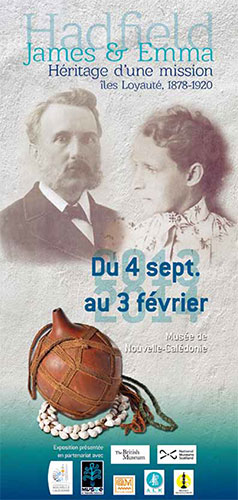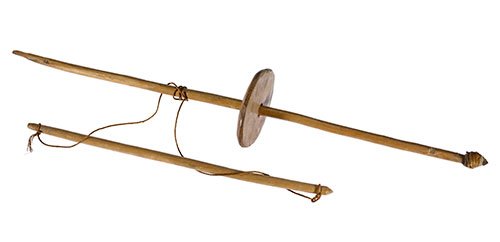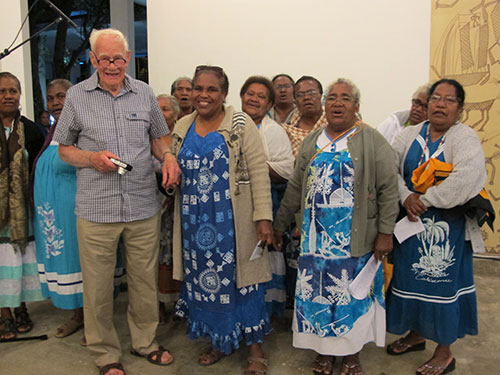An exhibition at the Museum of New Caledonia has told the story of the Reverend James Hadfield and Mrs Emma Hadfield, and their 40 years as missionaries in the Loyalty Islands. This exhibition included 13 artefacts from National Museums Scotland’s Hadfield collections, and is the first to look in detail at Loyalty Islands history and culture.

In 1910 James and Emma took a year’s break from their work in the Pacific and returned to Great Britain to stay with their son, James Arthur Hadfield, minister of the Kirk Memorial Church and resident in Edinburgh. Whilst in Edinburgh they offered a ‘Collection from New Caledonia and the Loyalty Islands’ on loan to the Royal Scottish Museum (now the National Museum of Scotland). It was displayed in the Ethnographical Gallery, before being purchased for the museum’s permanent collection, where it remains today.
In fact, two collections related to the Hadfields were placed on loan to the museum in 1910. The first, described as a ‘Collection from South Seas’, comprised 105 artefacts and arrived in the museum on 26 February. It was registered as being from the Reverend James Arthur Hadfield of Edinburgh, the son of James and Emma. This is presumed to be a collection given to her son by Emma Hadfield, as the original entry in the Loans Register cites ‘Mrs Hadfield’ as the source.
Two months later the second collection, noted above, was lent to the museum by Reverend James Hadfield. This collection comprised 94 objects, all but three of which were purchased for the permanent collections. The conversion of this loan to the permanent collection was significant enough to be highlighted in the museum’s 1911 annual report: “The most important additions to the Ethnographical gallery are the large groups of objects from Central Australia and from New Caledonia. Both provide specimens which the collection almost entirely lacked, and in both cases they consist of objects collected on the spot and brought to the Museum direct from the hands of the native peoples who made and used them.”
The year 1910 was a significant one for missionaries in Edinburgh. For 10 days in June the city hosted the World Missionary Conference. The collections on display in Edinburgh would immediately have been seen by the global missionary community, as a reception for delegates and their guests was hosted at the museum and attended by over 4,000 people.
The original loan remained with the museum until 1962, when James Arthur Hadfield, by now approaching his eighties, contacted the museum. After a short correspondence, the museum returned the collection to him in good order. It is probably at around this time that the artefacts were dispersed amongst the family, only to be reassembled nearly 50 years later and gifted to the Museum of New Caledonia in 2009. Today the only evidence of the time spent at National Museums Scotland are fragments of the loan labels glued onto the objects.
At the time of the purchase of the second loan, three finimeciwe necklaces of jade stone beads decorated with flying fox hair strands were held back from the purchase and remained on loan. Over the years the museum lost touch with the family and they became unaware of the continued existence of the three necklaces. The Hadfield collection maintained its place in the museum’s public galleries, surviving redisplays in the 1920s and again in the 1970s, although by the 1990s only one necklace remained on display in the Wider World gallery, and as it was on loan the label clearly attributed it to the Reverend James Hadfield. The object and label were spotted by a member of the Hadfield family during a visit and contact with the museum was renewed.

Visits from different family members over subsequent years and discussions on the cultural value of the necklaces led to their return to the family in November 2008, and in turn the gift of the Meciwa, along with many more items, to the Museum of New Caledonia.


This gift was of such significance that the Museum of New Caledonia immediately began researching the collection in order to put on a special exhibition. The Hadfield family’s gift had increased the national holdings of Loyalty Islands artefacts from less than 10 historic items to over 100. The finimeciwe necklaces had found a wonderful new home. The planned exhibition sought to place the family collection on display along with some of the best pieces from National Museums Scotland and British Museum collections.
Last September I travelled with Jill Hasell of the British Museum to the Pacific to courier the exhibition loans to the Museum of New Caledonia. Over an intense week objects were unpacked, condition checked, mounts made and installed in the exhibition cases. As each case was completed with the help of the staff of the Museum, many of whom are Loyalty Islanders, there was a real excitement about having the collection on display for the first time.
At the opening a group of dancers led guests of honour Douglas Hadfield, grandson of the missionaries, now in his nineties, along with his wife and two children into the exhibition, serenaded by the local church choir who sang a newly-composed hymn dedicated to the life of James and Emma and their work in the Loyalty Islands.

For National Museums Scotland this loan has provided a rare opportunity to lend artefacts to their country of origin, reconnecting them to the place and the descendants of their makers, and to gain access to new research and interpretation of the artefacts. It has also been a chance to reconnect with the original collectors’ family and learn more about their history. As a result the objects will return to Scotland with enhanced documentation, including the local names for all the objects and further information on their use, which will be added to our collections database.
Historically National Museums Scotland always took in long-term loans as they provided an excellent opportunity to broaden the scale and scope of the collections on display, and safeguard material whilst funds were sought for their purchase or lenders were persuaded to become donors. What makes this collection so special are the ongoing connections between the Hadfield family and Loyalty Islanders. Their collections have created a network of objects and people that connect forever the institutions that house the collections with each other and the Loyalty Islanders, enabling further research and greater access to the collections. At the National Museum of Scotland we continue to display the Hadfield collection in the permanent gallery, Facing the Sea, reinterpreted and renewed for today’s audiences.
